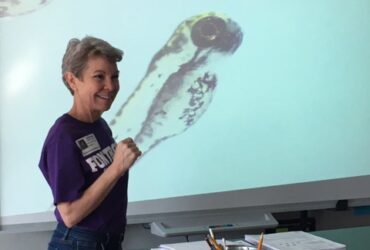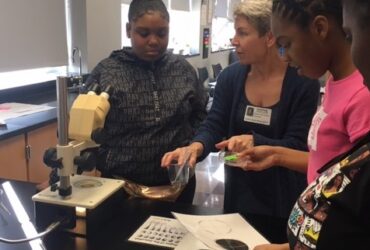Fontbonne biological sciences professor Dr. Stephenie Paine-Saunders recognized an opportunity to inspire young scientists during a 2018 zebrafish workshop in Woods Hole, Massachusetts, where she attended a presentation by Dr. Steven Farber. Dr. Farber, a scientific researcher at the Carnegie Institution for Science in Baltimore, Maryland, is the co-creator and scientific advisor of BioEYES, a K-12 science education program that provides classroom-based learning opportunities through the use of live zebrafish.

The BioEYES program is designed to foster enthusiasm for science by providing students with a hands-on experience breeding zebrafish and observing the development of zebrafish embryos. This program is a week-long opportunity for students to explore genetic and developmental concepts with live organisms. Students make hypotheses, observe and record data, construct graphs, and make conclusions in their BioEYES journals.
“I immediately knew I wanted to bring BioEYES to St. Louis middle schools,” Dr. Paine-Saunders said. “Middle school tends to be the time when many students decide if they like science or if they have the support to pursue a career in science. It is essential to provide encouragement as well as exciting, hands-on learning opportunities like BioEYES to this age group.”
After returning from the workshop, Dr. Paine-Saunders began the process of securing funding to launch a BioEYES pilot program. She applied for a financial award from the Fontbonne Community Connection (FCC), a unique women’s giving circle that provides grants to Fontbonne faculty, staff, and students to advance their educational goals and promote the university.
In July of 2019, Dr. Paine-Saunders received a financial award from the FCC that allowed her to establish a BioEYES pilot program that included training and classroom instruction. In December 2019, she and Denise Driscoll, Fontbonne’s Clinical Experiences Partnership Coordinator, received training to become BioEYES outreach educators. Five teachers and the science coordinator from Brittany Woods Middle School in University City, Missouri, also participated in the training to learn about BioEYES and how to direct zebrafish classroom experiments.
In March of 2020, Dr. Paine-Saunders, Driscoll, and the trained teachers launched the first BioEYES program in Missouri at Brittany Woods. Approximately 200 eighth-grade students spent one week mating the zebrafish, raising the resulting embryos, and observing the hatched larvae with microscopes.
“It was an extremely positive experience for the participating students,” Dr. Paine-Saunders said. “If not for BioEYES, many would not have the opportunity to work with live animals, care for them, and collect data. Some had never used a microscope before.”

Dr. Paine-Saunders and Driscoll plan to bring Project BioEYES back to Brittany Woods in the spring of 2021. They would also like to expand the program to other elementary, middle, and high schools in the St. Louis area, but require additional funding for training and supplies.
“This program has the potential to serve so many students at schools that do not currently have the resources to provide these hands-on experiments,” Dr. Paine-Saunders said. “I’ve been overwhelmed by the generosity and support we have received from the FCC and from Dr. Lila Solnica-Krezel at Washington University, who donated the zebrafish and a microscope. We are continuing to piece together the needed funds to not only continue, but also to grow BioEYES.”
To learn more about BioEYES or to make a donation, contact Dr. Paine-Saunders at SPaine-Saunders@fontbonne.edu.

